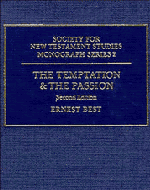Preface to the First Edition
Published online by Cambridge University Press: 28 October 2009
Summary
Our primary concern in the following essay is with the soteriology of Mark: What does Mark hold to have been achieved by the life, death and resurrection of Jesus the Christ? Since it is often held that the death and resurrection of Jesus signalled his defeat of Satan, it is necessary to begin with a study of the Markan Temptation narrative; this is followed by an examination of the general place in the Gospel of demonic forces and of Satan. Thereafter we turn to a more direct consideration of our main aim.
Because we are not interested in what Jesus himself thought of the meaning and purpose of his life and death but only with the view that Mark adopts we have to proceed with caution. It is necessary to distinguish in relation to the pericopae of the Markan account the form in which the tradition reached him and the modifications he gave to it. Thus in any particular incident we may have to separate Mark's view of the incident from its original place in the life of Jesus and also from the varying modifications which thereafter it may have received in the early Church. To single out the Markan contribution we need to look at the phrases by which Mark has joined together the incidents he uses; these appear at the beginnings and ends of pericopae: the Markan seams. We also examine the explanatory additions Mark may have made within incidents in order to align them with his main purpose. This by no means exhausts the Markan editing.
- Type
- Chapter
- Information
- The Temptation and the PassionThe Markan Soteriology, pp. ix - xiiPublisher: Cambridge University PressPrint publication year: 1990



